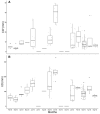Ontogenetic niche specialization of the spider crab Libinia ferreirae associated with the medusa Lychnorhiza lucerna
- PMID: 36324529
- PMCID: PMC9616071
- DOI: 10.1093/cz/zoab095
Ontogenetic niche specialization of the spider crab Libinia ferreirae associated with the medusa Lychnorhiza lucerna
Abstract
Symbiotic relationships in marine environments are not fixed and can change throughout the animal's life. This study investigated the ontogeny of symbiosis of the spider crab Libinia ferreirae with the host medusa Lychnorhiza lucerna. We described the type of relationship, the temporal correlation among species, and food habits. More than 50% of the sampled crabs were symbionts, most in early life stages. The highest number of crabs found in a single medusa was 11. Symbiosis was observed throughout most of the year but was more evident in warm periods. The crab has many benefits in this relationship with a medusa. One is the use of food resources captured by the medusa, primarily copepods. Because the crab steals the medusa's food, it is a kleptoparasitic relationship. There is a niche partition between symbiont and the free-living crabs as they occupy different habitats and use nonoverlapping food resources. Previous research reported that symbiosis first developed during the crab's last larval phase (megalopa) when crab and medusa are in the same habitat. Observation of the crab's behavior shows that symbiosis occurs when the crab can grab to the medusa when the host touches the sea bottom. The crab also took advantage of water currents, releasing itself from the substrate and then drifting toward the medusa. The symbiotic relationship that crabs have with the medusa provides then with a nursery, food resources, shelter, dispersion, and decreased competition with free-living adult crabs, all essential for the crab's survival.
Keywords: behavior; development; kleptoparasitism; megalopa; niche segregation.
© The Author(s) (2021). Published by Oxford University Press on behalf of Editorial Office, Current Zoology.
Figures









References
-
- Anger K, Harms J, Montu M, Bakker CD, 1989. Growth and respiration during the larval development of a tropical spider crab Libinia ferreirae (Decapoda: majidae). Mar Ecol Prog Ser 54:43–50.
-
- Baeza JA, de Paiva Barros-Alves S, Lucena RA, Lima SFB, Alves DFR, 2017. Host-use pattern of the shrimp Periclimenes paivai on the scyphozoan jellyfish Lychnorhiza lucerna: probing for territoriality and inferring its mating system. Helgol Mar Res 71:17.
-
- Barros SP, Cobo VJ, Fransozo A, 2008. Feeding habits of the spider crab Libinia spinosa H. Milne Edwards, 1834 (Decapoda, Brachyura) in Ubatuba Bay, São Paulo, Brazil. Braz Arch Biol Technol 51:413–417.
-
- Bauer RT, 1981. Color patterns of the shrimps Heptacarpus pictus and H. paludicola (Caridea: hippolytidae). Mar Biol 64:141–152.
-
- Carrizo SS, Schiariti A, Nagata RM, Morandini AC, 2016. Preliminary observations on ephyrae predation by Lychnorhiza lucerna medusa (Scyphozoa; Rhizostomeae). Zool Gärt 85:74–83.
LinkOut - more resources
Full Text Sources
